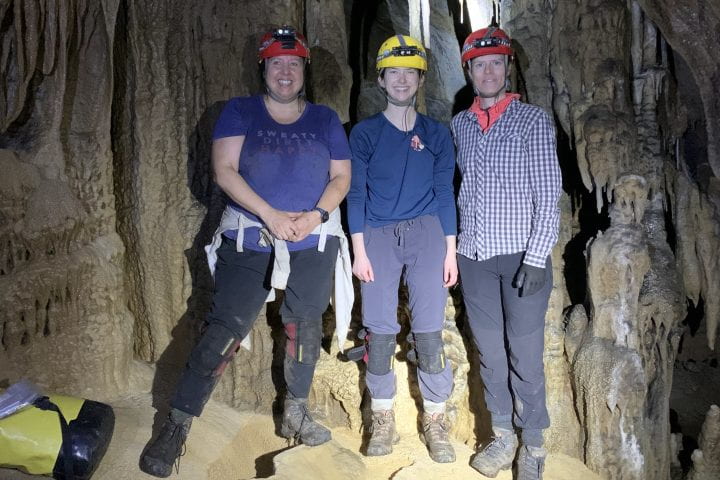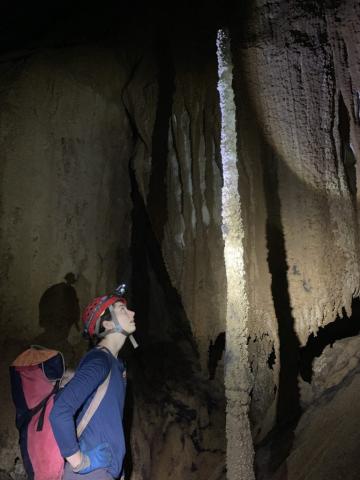UC Irvine-led study links ice sheet retreat with autumnal monsoons in central Vietnam

From left, Kathleen Johnson, UCI professor of Earth system science; Elizabeth Patterson, UCI Ph.D. candidate in Earth system science; and Annabel Wolf, UCI postdoctoral scholar in Earth system science, explored a cave in Phong Nha-Ke Bang National Park in central Vietnam in search of stalagmites that preserve records of past climate changes in Southeast Asia.
Irvine, Calif., June 26, 2023 — Rising sea levels from melting land ice caused an abrupt transition from dry to wet conditions in a subregion of mainland Southeast Asia some 14,000 years ago, accounting for the unique autumnal monsoons in this area. Researchers at the University of California, Irvine and other international institutions found evidence of this shift in the geochemical signals stored in a stalagmite taken from a remote cave in central Vietnam.
The researchers used a previously broken 12-foot-long speleothem to create a hydroclimate history of the region dating between 4,000 and 45,000 years in the past. In a Proceedings of the National Academy of Sciences study, the UCI-led team found dry conditions occurred in central Vietnam at the peak of the last ice age, when 25 percent of Earth’s land regions were covered in glacial ice. As the ice sheets melted during the end of this period, rising oceans inundated previously dry land, and rainfall abruptly increased, creating a climate much more similar to what is observed today.
“Through our geochemical analysis of stalagmite minerals and climate model simulations, we have been able to confirm that changes in sea level contributed to variations in autumn rainfall amount in central Vietnam,” said lead author Elizabeth Patterson, UCI Ph.D. candidate in Earth system science. “This previously unknown influence on mainland Southeast Asia hydroclimate demonstrates that sea level has been a dominant driver of monsoon rainfall variability over the last 45,000 years.”

Patterson said that when more of Earth’s water was held as ice and global sea level was low, the Gulf of Tonkin to the east of Vietnam and the South China Shelf was dry land, causing less evaporated water vapor to reach central Vietnam. As ice sheets melted, exposed terrain began to be covered with water, increasing regional convection and moisture transport.
More than 650 million people living in Southeast Asia are impacted by heavy rainfall during the region’s summer monsoon months. But in topographically isolated central Vietnam – where water vapor bumps up against the Truong Son Mountains that run north to south along the Vietnam-Laos border – the rainy season comes in September to November.
This distinction inspired the UCI-led team to explore caves in Phong Nha-Ke Bang National Park to look for evidence of the link between sea level rise and autumn monsoons in this unique region. The nearly 4-meter-long stalagmite they found grew continuously between 4,000 and 45,000 years ago in the remote Hoa Huong cave. The UCI-led team collected this sample in March 2020 on an overnight expedition to the remote cave in partnership with researchers and managers at Phong Nha-Ke Bang National Park, a UNESCO world heritage site.
The researchers relied on their understanding of cave hydrology and geochemistry, as well as stalagmite formation processes, to construct a climate history based on isotopic and elemental variations within the stalagmite layers. As water flows through the limestone rock above the cave, certain elements and isotopes accumulate in the drip water that ultimately forms the stalagmite. The relative concentration of these elements and isotopes change depending on whether the climate is wet or dry.
“Stalagmites grow drip by drip; calcite precipitates out of these droplets, depositing new layers through time,” she said. “We measure stable oxygen and carbon isotopes and trace elements, such as magnesium, from these layers and see how they change through time. These measurements allow us to reconstruct how rainfall amount has changed in Vietnam over the last 45,000 years.”

According to senior co-author Kathleen Johnson, UCI professor of Earth system science, this study demonstrates the power of using Earth’s own natural climate archives – in this case the stalagmite minerals that accumulated slowly over thousands of years – to study the timing and mechanisms of past climate changes.
“Our comparison with climate model data confirms that the models are accurately capturing the influence of deglacial sea level rise and abrupt climate changes on Vietnam hydroclimate,” she said. “By validating the models in this way, we can be more confident in projections of future hydroclimate in this sensitive region as we go deeper into the anthropogenic climate change era.”
Collaborating with Patterson and Johnson in this project, which was funded by the National Science Foundation, were researchers from William Paterson University in Wayne, New Jersey; Massachusetts Institute of Technology, Cambridge, Mass.; the Berkeley Geochronology Center in Berkeley, Calif.; Brown University, Providence, R.I.; University of California, Santa Cruz; Northumbria University, Newcastle, England; Rutgers University, Piscataway, N.J.; University of York, York, England; and Vietnam National University, Hanoi.
About UCI’s Brilliant Future campaign: Publicly launched on Oct. 4, 2019, the Brilliant Future campaign aims to raise awareness and support for UCI. By engaging 75,000 alumni and garnering $2 billion in philanthropic investment, UCI seeks to reach new heights of excellence in student success, health and wellness, research and more. The School of Physical Sciences plays a vital role in the success of the campaign. Learn more by visiting https://brilliantfuture.uci.edu/uci-school-of-physical-sciences/.
About the University of California, Irvine: Founded in 1965, UCI is a member of the prestigious Association of American Universities and is ranked among the nation’s top 10 public universities by U.S. News & World Report. The campus has produced five Nobel laureates and is known for its academic achievement, premier research, innovation and anteater mascot. Led by Chancellor Howard Gillman, UCI has more than 36,000 students and offers 224 degree programs. It’s located in one of the world’s safest and most economically vibrant communities and is Orange County’s second-largest employer, contributing $7 billion annually to the local economy and $8 billion statewide. For more on UCI, visit www.uci.edu.
Media access: Radio programs/stations may, for a fee, use an on-campus ISDN line to interview UCI faculty and experts, subject to availability and university approval. For more UCI news, visit news.uci.edu. Additional resources for journalists may be found at communications.uci.edu/for-journalists.
